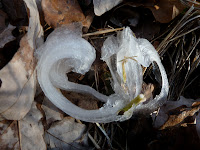 | |
| Early Frost Flower on stem |
There are a few native plants which can be counted on to grow frost flowers. Freezing temperatures forces water out through splits in the stem’s epidermis, creating ribbons of ice so thin that you can see your finger print through them. The stems remain intact as the ice may extend several feet up the stem at the first “flowering.” Subsequent ribbons tend to form around the base of the stem, frequently creating thicker spirals.
 |
| First bloom- 3 foot tall |
 |
| This ribbons of ice |
The two common species of plants producing frost flowers in our area are White Crownbeard, Verbesina virginica, Yellow Ironweed, Verbesina alternifolia, both of which are also called Frostweed. These are commonly found in southern Missouri seen in large numbers on roadsides, the edges of fields, thickets and woods.
 |
| Late blossom at stalk base |
 |
| Ice Ribbons |
Two other species are known to produce smaller frost flowers, Dittany, Cunila origanoides and Frostweed, Helianthemum canadense. There are single incidental reports of other plants producing these icy ribbons.
Challenge
This is an area which is ripe for citizen science. Since finding frost flowers requires getting out early on frosty mornings, many other species may be producing small frost flowers that go unnoticed. I would challenge you to watch the weather next fall for the first frost and wander your garden and woods. If you are a gardener, look carefully around to see if any of your plants have basal ice ribbons. If you can find them on other plants, photograph them, identify the plant if possible and send them to me at rekipfer@gmail.com.
- biosci.utexas.edu
- http://my.ilstu.edu, /~jrcarter/ice/diurnal/
- http://my.ilstu.edu/~jrcarter/ice/diurnal/wood/